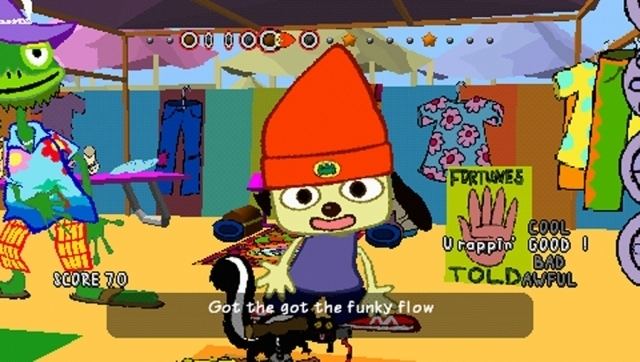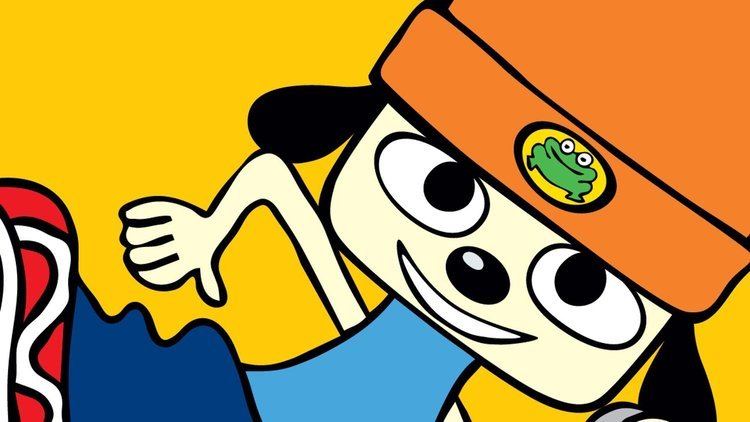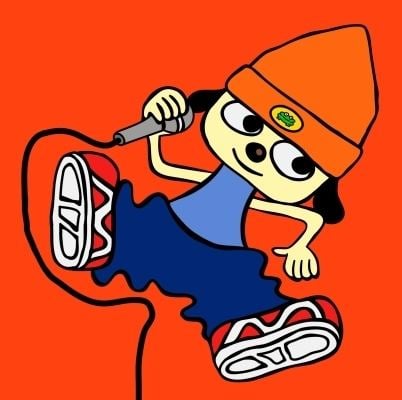8.4 /10 1 Votes8.4
Artist(s) Rodney Greenblat Mode(s) Single-player | 4.2/5 Emuparadise Writer(s) Gabin Ito Initial release date 6 December 1996 | |||||||||||||||||||||||||||||||||
 | ||||||||||||||||||||||||||||||||||
Publisher(s) Sony Computer Entertainment Composer(s) Masaya MatsuuraYoshihisa Suzuki Similar NanaOn-Sha games, Music video games, Other games | ||||||||||||||||||||||||||||||||||
Parappa the rapper stage 1
PaRappa the Rapper (パラッパラッパー, Parappa Rappā) is a rhythm video game developed by NanaOn-Sha and published by Sony Computer Entertainment for the PlayStation. Created by music producer Masaya Matsuura in collaboration with artist Rodney Greenblat, the game features unique visual design and rap-based gameplay and is considered to be one of the first modern rhythm games. The game was first released in Japan in 1996 and was later released in North America and Europe in 1997. The game was ported to the PlayStation Portable in 2006 and a remastered version will be released for PlayStation 4 in 2017.
Contents
- Parappa the rapper stage 1
- Parappa the rapper 2 gameplay video 1 ps2 on ps4
- Gameplay
- Plot
- Development
- Reception
- Sequels
- Ports
- Appearances in other games
- Other media
- References

The game spawned two follow-up titles; a guitar-based spin-off titled UmJammer Lammy, released in 1999 for the PlayStation, and a direct sequel, PaRappa the Rapper 2, released for the PlayStation 2 in 2001. A television anime series based on the games aired in Japan between April 2001 and January 2002, with a short spin-off series to airing from October 2016.

Parappa the rapper 2 gameplay video 1 ps2 on ps4
Gameplay

PaRappa the Rapper is a rhythm game in which the main character, Parappa, must make his way through each of the game's six stages by rapping. Each stage constantly alternates between the stage's teacher and Parappa. As the teacher raps, a bar at the top of the screen will appear, showing symbols that match up to the teacher's lyrics. The player must then make Parappa rap in response to the teacher by pressing the buttons with the correct timing to match the teacher's line.

During gameplay, a "U Rappin'" meter determines the player's performance, ranking it as either Awful, Bad, Good or Cool. By consistently staying on beat, players will stay in the Good ranking area. If the player performs a bad line, a lower ranking will flash, and if the player performs badly twice in a row, he will drop to Bad, followed by Awful. To regain a higher ranking, the player must play well twice in a row to move up a rank. To clear a stage, the player must have a Good ranking by the end of the song. If the player ends the song on a Bad or Awful ranking, or drops below Awful ranking at any point in the song, they will fail the song and have to start over. After the game has been cleared once, the player can attempt to achieve a Cool ranking. This is achieved by freestyling in a manner different from the predetermined lyric. If the player performs a successfully impressive freestyle when the Cool rank is flashing, they will enter Cool mode. In this mode, the teacher will leave the stage, allowing the player to rap freely and earn some large points. If the freestyling fails to impress twice in a row, the teacher will return and gameplay will resume in the Good ranking. Ending the stage with a Cool rank often results in a special level ending, and clearing all stages on Cool Mode unlocks a bonus mode featuring Katy Kat and Sunny Funny.
Rank-changing aspects of a level are only apparent during the first of every two lines. If the player successfully times the first line of a pair, but fails on the second, the rank meter will not blink Bad or Awful. Likewise, once the game has been cleared, a Good play is only necessary on the first of every two lines to get a shot at Cool mode on the second line.
Plot
The player takes on the role of Parappa, a paper-thin rapping dog, who is trying to win the heart of a flower-like girl named Sunny Funny. However, he is intimidated by the presence of Joe Chin, a rich, narcissistic dog who goes overboard with his attempts to impress Sunny. To impress Sunny Funny, PaRappa learns to fight at a kung-fu dojo, and takes a driver's education course to get his license. However, when he crashes his dad's car, he has to earn money at a flea market to pay for it. When Sunny's birthday comes up, Parappa has to get cake, but ends up ruining it after an encounter with Joe. He makes a new one by watching a cooking show and proceeds to eat a lot of it on the day. When spending some time alone with Sunny, he is suddenly overcome with the need to go to the bathroom and has to rap against his former teachers to get to the front of the queue. Then one night, Parappa is invited to Club Fun, and asks Sunny to go with him, to which she agrees. Parappa then raps on stage with everybody, rapping solo at the end of the song and expressing his feelings for Sunny.
Development
The unique visual style is that of Rodney Greenblat, an American graphic artist who is popular in Japan. Similar to the Paper Mario series by Nintendo, all of the characters appear to be two-dimensional beings cut from paper while the surroundings are primarily three-dimensional. On his website, Greenblat remembers that the idea to make the characters flat was Matsurra's idea, after creating a mock-up with characters from Greenblat's Dazzeloids CD-ROM. While the setting is a bright interpretation of an urban city, the characters range from anthropomorphic animals such as frogs, beetles, and dogs, to lively versions of normally inanimate objects including onions, and flowers. Its also the first PlayStation game as well as one of the first E rated game to use ingame Motion Capture for more realistic dancing but only for characters like PaRappa and The Rap Masters (as they're the only in game characters).
Reception
PaRappa the Rapper received positive reviews, it sold 761,621 copies in Japan by 1997, making it the 7th best-selling game of the year in that region. As of 26 December 2004, the original version of the game has sold 937,976 copies in Japan, while its PlayStation the Best re-release has sold 306,261 copies meaning it has sold nearly 1.4 Million copies total.
At the first annual Interactive Achievement Awards in 1998, PaRappa the Rapper won the awards for "Outstanding Achievement in Interactive Design" and "Outstanding Achievement in Sound and Music", and was nominated for "Interactive Title of the Year". In the final issue of the Official UK PlayStation Magazine, the game was chosen as the 3rd best game of all time.
Sequels
PaRappa the Rapper was followed by a spin-off titled UmJammer Lammy, which was released on 18 March 1999 in Japan. The game featured a new cast of characters, multiplayer modes and focused on guitar play, but very similar game play. A bonus mode was included in which the entire game could be replayed with Parappa as the protagonist, complete with his own versions of the game's stages. An arcade version of the game produced by Namco was also released. A direct sequel, PaRappa the Rapper 2, was released for the PlayStation 2 in 2001 in Japan and 2002 in North America and Europe. A smartphone game is currently being developed by ForwardWorks.
Ports
PaRappa the Rapper was released for PlayStation Portable in Japan in December 2006 and in North America and Europe in July 2007 for the game's tenth anniversary. The port, developed by Japan Studio and epics, features ad hoc multiplayer mode for up to four players and the ability to download remixed versions of the existing songs. In conjunction with the PSP release, Sony, for a limited time, freely released the soundtrack. In a 2008 Famitsu interview, Masaya Matsuura revealed that a brand new song created for the PSP release, "Believe in Yourself," was cut due to development time constraints. A high definition port of the game for PlayStation 4 will be released in 2017. A playable demo was released on December 3, 2016, celebrating the game's 20th anniversary. In the North American version of both the PSP and PS4 ports, cutscene dialogue referencing fast food was edited to remove the term "frosty", which is trademarked in the United States by Wendy's restaurant.
Appearances in other games
Parappa appears as a playable character in PlayStation All-Stars Battle Royale, released for PlayStation 3 and PlayStation Vita in November 2012. His play style revolves around using his Karate taught to him by Master Onion as well as moves inspired by his love of music and skateboarding.
Rodney Greenblat, the man responsible for PaRappa's art style, was asked about PaRappa being a playable fighter in PlayStation All-Stars Battle Royale. Greenblat was happy to see Parappa return to video games, but he was not happy to see him in a violent game. "I’m very happy that Parappa is making a bit of a comeback, but not so happy about him being in a weapon filled battle game. Actually the Battle Royale game is fun, and I have to do what I can to get Parappa back in the game scene. My hope is that Sony realizes the golden true potential of Parappa and asks me to design some new games. I’ve learned a lot, and I think Parappa could be great again," said Greenblat.
Other media
A 30-episode television anime series based on the game franchise, produced by J.C. Staff and Production I.G, aired in Japan between April 14, 2001 and January 14, 2002. A new anime series was announced. A short anime series by Doga Kobo, titled PJ Berri no Mogu Mogu Munya Munya (PJベリーのもぐもぐむにゃむにゃ, PJ Berri's Munching Mumbling), began airing in October 2016 as part of the #Hi Paul variety show, following a pilot episode which aired on August 18, 2016.
